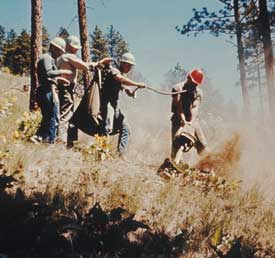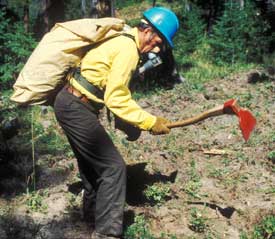
Featured Topic
Research and Development in Wildland Firefighting
Brian J. Sharkey, Ph.D., MTDC; Brent Ruby, Ph.D., and Steven Gaskill, Ph.D., University of Montana Human Performance Laboratory
During the late 1950s, a group at the U.S. Department of Agriculture Forest Service's Aerial Fire Depot in Missoula, MT, began working on equipment for smokejumping and air cargo drops. This work led to the establishment of the Missoula Equipment Development Center (now the Missoula Technology and Development Center). In 1962, Center Director Herb Harris met with Charles Hertler and Walter Schwank of the University of Montana to discuss the importance of human factors in equipment design. Those conversations led to a cooperative research agreement and a longstanding relationship between MTDC and the University of Montana Human Performance Laboratory.
Since then, MTDC has maintained the agreement with the University's Human Performance Laboratory, working with university researchers and graduate students to improve the quality of laboratory and field studies. The agreement provides for studies to solve equipment, health, and safety problems.
MTDC uses a research and development model to develop and test solutions for field use. The model involves field and laboratory studies, product development and evaluation, and dissemination of results, leading to field adoption of solutions.
MTDC personnel involved in the cooperative agreement have included Cliff Blake (1962–1967), Art Jukkala (1968–1989), Dick Mangan (1990–1999), George Jackson (2000–2003), and Leslie Anderson (2004 to present). University researchers have included Wayne Sinning, Ph.D. (1962–1964), Brian Sharkey, Ph.D. (1965–1997), Brent Ruby, Ph.D. (1996 to present), and Steve Gaskill, Ph.D. (2000 to present). Brian Sharkey retired from the university in 1997 and coordinates the agreement at MTDC. This paper reviews the results of this cooperative agreement and considers wildland firefighting problems for future study.
Past ProjectsUnder the cooperative agreement, the initial work was conducted by Dr. Sinning and several graduate students. It included studies of energy expenditure and fatigue while firefighters were packing loads in backpacks of different design. Information was gathered from the field and in the laboratory on a treadmill designed and built by MTDC. Another study investigated the energy cost of building a fireline with a motorized flail trencher. Since Sinning's departure, Dr. Sharkey and his graduate students have conducted work in the following areas.

This 1963 study measured the energy cost of
using a flail trencher to build a fireline.
Job Demands—Field studies to determine the energy, cardiovascular, and thermal demands of fireline tasks led to the development of work capacity tests for wildland firefighters.
Equipment Carriers—One- and two-person motorized and human-powered equipment carriers were tested on the steep trail that switchbacks on Mount Sentinel behind the university campus.
Tools—Fireline construction tools were evaluated for performance and energy cost. MTDC developed the Combi tool that allows firefighters to produce 22 percent more fire-line than the pulaski, at a lower energy cost per foot of line (4.1 ft of fireline per liter of oxygen consumed, rather than 3.4).
|
|
Aerobic Fitness—Studies demonstrated a strong relationship between aerobic fitness and performance of fireline tasks, heat tolerance, and safety (as indicated by the ability to escape to a safety zone). Aerobic fitness was highly correlated to a firefighter's speed when escaping to a safety zone (r = 0.87).
Work Capacity Tests—Lab and field studies of fireline tasks led to the development of a test to measure aerobic fitness. The Step Test estimated the minimum aerobic fitness standard of 45 mL/kg-min. This test, introduced in 1975, was used until 1998 when new job-related tests were introduced. The Pack Test, Field Test, and Walk Test were developed to evaluate arduous, moderate, and light levels of work capacity.
Muscular Fitness—Field studies identified the relationship of muscular fitness to performance in wildland firefighting tasks. The Pack Test and Field Test incorporate elements of muscular fitness while maintaining the aerobic fitness standard.
Fitness Programs—The booklet, Fitness and Work Capacity (1977), helped readers learn how to develop and maintain aerobic and muscular fitness. A second edition was published in 1997.
Health Screening Materials—Health screening materials were prepared to help employees evaluate their readiness for training, testing, and wildland firefighting.
Employee Health Programs—Employee health (wellness) materials were introduced in 1980 and updated in 1993.
Health Hazards of Smoke—MTDC coordinated an 8-year program that focused on the effects of wood smoke on the health of wildland firefighters. The program included: employee exposure, epidemiology, health effects, risk assessment, and risk management. The program's progress was summarized in 12 issues of Health Hazards of Smoke. A project summary and the recommendations of a consensus conference were published in 1997.
Fatigue—MTDC conducted literature reviews and field studies to determine work/rest standards (2/1 ratio), shift length, assignment length, and fatigue countermeasures. Measures of immune function and fatigue were used to determine the effects of long shifts and assignments.
Uniforms—Uniforms have been studied in the Human Performance Laboratory's environmental chamber. The balance between protection and comfort has been analyzed. The lab's findings agree with those of Australian researchers: "Clearly, the task of firefighters' clothing is not to keep heat out, but to let it out" (Budd and Brotherhood 1996).
Heat Stress—Heat stress has been studied in the lab's environmental chamber and in the field. While early studies used a rectal probe, recent studies use an ingested pill to transmit core temperature to a recorder on the subject's hip. Studies show the value of acclimatization and fitness, and the need to hydrate before, during, and after work.
Hydration—Firefighters generate 7.5 kcal of heat during each minute of work, or more than 400 kcal/h. Additional heat (about 180 kcal/h) comes from the environment and the fire. This heat load (400 + 180 = 580 kcal/h) can be dissipated with the evaporation of 1 L of sweat. Firefighters should consume 1 L of fluid for each hour of work to avoid fluid loss, fatigue, and heat stress. Carbohydrate/electrolyte (C/E) beverages increase fluid intake and maintain fluid levels, blood glucose, work output, cognitive function, mood, and immune function.
Energy Balance—Firefighter energy expenditure has been studied since the 1960s. Our latest studies, using doubly labeled water techniques during several days of actual fire suppression, document exceedingly high levels of energy expenditure (3,500 to 6,300 kcal/day) and an overall loss of total body water and body weight. Analysis of fire camp meals showed that the meals provide enough energy, if firefighters eat enough.
We conducted field studies of supplemental carbohydrate drinks and rations to provide energy throughout the work shift. Crossover studies demonstrated maintenance of blood glucose and an increase in self-selected work output when supplemental carbohydrates were consumed throughout the day. We have also demonstrated that immune function was better maintained when supplemental carbohydrates were consumed.
Nutrition—We have analyzed the energy and nutrient value of fire camp meals, and the need for vitamin/mineral supplements. The increased energy and nutrient demands of wildland firefighting should be met by a balanced diet based on a variety of foods, including carbohydrate and protein-rich foods, nine or more servings of fruits and vegetables, and several servings of whole grains daily.
Immune Function—We have used salivary immunoglobulin A (sIgA), the first line of defense against respiratory tract infections, as an objective measure of fatigue during prolonged work shifts and assignments. Using sIgA, we found recovery from fatigue was adequate after a 14-hour shift, but not after 21 hours of arduous work. Working a 21-hour shift led to several days of suppressed immune function.

Laboratory and field studies have been reported at national and international meetings and in research journals. Projects have been reported in tech tips (such as Feeding the Wildland Firefighter), booklets (such as Fitness and Work Capacity), and reports (Health Hazards of Smoke; Wildland Firefighter Health and Safety Reports). In addition to project work, MTDC has provided technical services, developed video and presentations (such as Fatigue Awareness), and advised the Forest Service in numerous areas.
Recent WorkSince 1996, Dr. Brent Ruby (University of Montana) has conducted studies of wildland firefighters. Based on the similarity of wildland firefighting to military operations, Ruby and Sharkey received a U.S. Department of Defense grant to study energy expenditure and hydration in wildland firefighters. Dr. Steve Gaskill joined the lab in 2000. Dr. Carla Cox, a registered dietician, has become actively involved in firefighter nutrition issues. Relationships with scientists at several universities and in military research groups expand the scope of the work. During the past fire season, equipment loaned by the U.S. Army Research Institute of Environmental Medicine and several equipment manufacturers was used in field studies. The university relationship allows substantial funding to be leveraged through other partners, making these studies cost effective for Federal agencies.
SummaryThis work has led to tests, programs, tools, hydration and nutrition guidance, informed purchasing decisions, and other accomplishments. It has improved the performance, health (immune function), and safety of wildland firefighters. According to a study for the U.S. Fire Administration (TriData Corp. 2002), wildland firefighter standards of physical fitness are associated with a much lower rate of death from heart attacks (7 percent for wildland firefighters compared to 47 percent for other firefighters).
New DirectionsMTDC and cooperators at the University of Montana will continue to study factors that maintain cognitive function during prolonged arduous work, including supplemental feeding, hydration, work/rest guidelines, and fatigue countermeasures. We will study the relationships among hydration strategies, temperature regulation, and heat disorders. We will look at the relationships among diet, fitness, and immune function. We will work with the U.S. Army Research Institute for Environmental Medicine to test alternative feeding strategies in field conditions. We hope to extend these studies to include the role of micronutrients and their relationships to performance and health in wildland firefighters. Doing so will require field studies of food intake, nutritional guidance program; and, if needed, introduction of a ration component to meet micronutrient needs.
The Wildland Firefighter Health and Safety project was outlined in 1999 with help from participants at the International Association of Wildland Fire Safety Summit. We need your advice to help us focus our work. We hope you will help us identify new directions for our work and priorities for future studies. Contact Brian Sharkey at bsharkey@fs.fed.us or 406–329–3989. We look forward to hearing from you.
For additional information, visit the MTDC Web site http://www.fs.fed.us//t-d
Note: The Murdock Charitable Trust has awarded the University of Montana Human Performance Laboratory a grant to expand its capabilities for field and laboratory research. The grant will be used to purchase equipment that will enhance studies of wildland firefighters, the military, and others involved in prolonged arduous work.




